PHE5PAP: Cardiovascular Disease and Public Health Report, La Trobe Uni
VerifiedAdded on 2023/01/18
|20
|5037
|98
Report
AI Summary
This report, prepared for a Public Health Policy and Practice course at La Trobe University, addresses the critical issue of cardiovascular disease (CVD) and its disproportionate impact on indigenous populations in Australia. The report begins with a comprehensive overview of CVD statistics, highlighting its global prevalence and the significant burden it places on low and middle-income countries, as well as the specific challenges faced in Australia, particularly among Aboriginal and Torres Strait Islander communities. The report analyzes the epidemiological factors contributing to the disease, including lifestyle risk factors, socioeconomic determinants, and the role of social disadvantage. Part B of the report presents a ministerial briefing paper, advocating for interventions to improve population health. It proposes health promotion activities as a key strategy, emphasizing the importance of awareness campaigns and community engagement. The briefing paper outlines the methods to be used, including social marketing and legislative measures, while also addressing potential ethical implications related to cultural sensitivities and the use of social media. The report aims to inform the Minister of Health about the urgency of the problem and the necessity of implementing effective strategies to mitigate the impact of CVD on vulnerable populations.
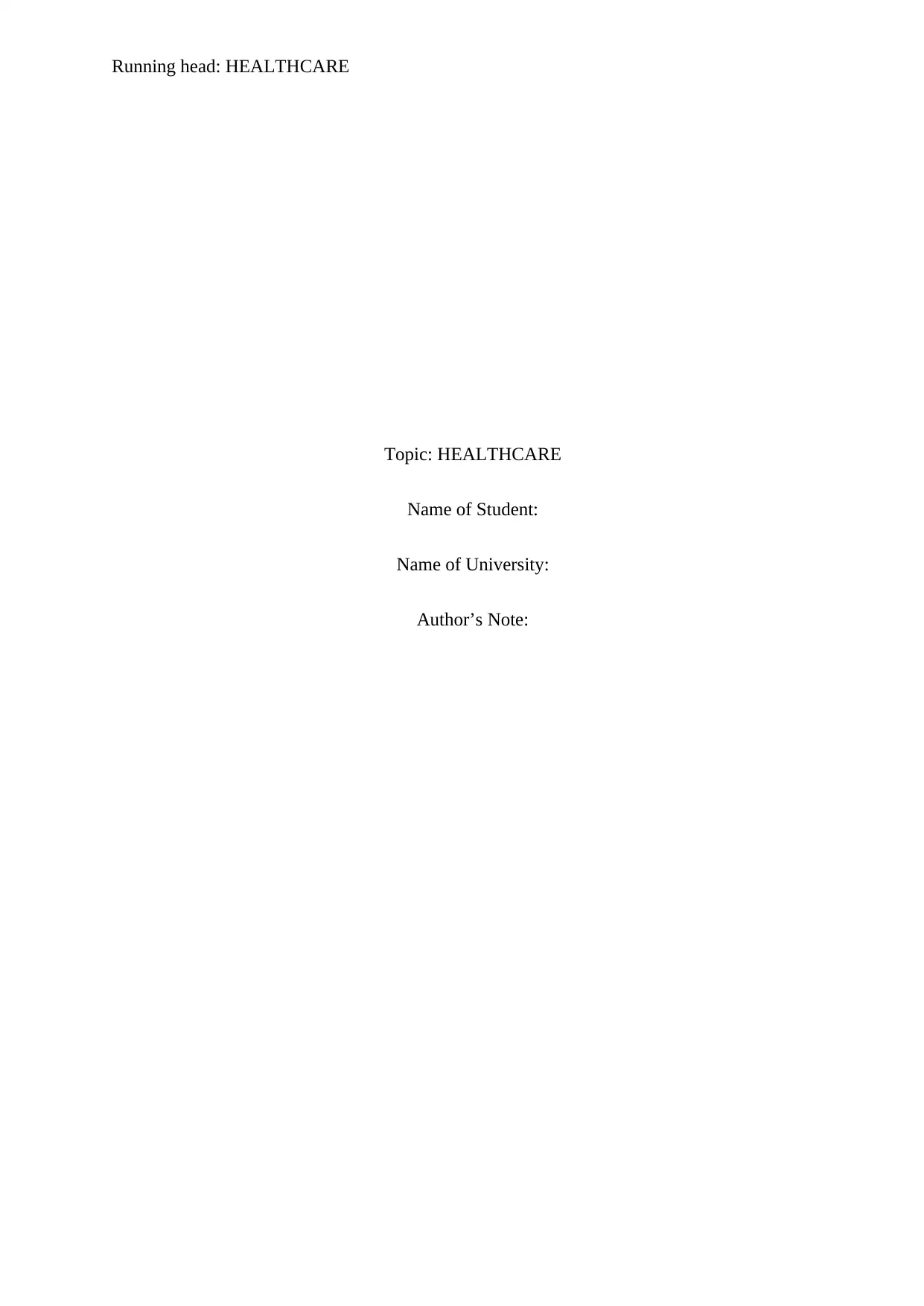
Running head: HEALTHCARE
Topic: HEALTHCARE
Name of Student:
Name of University:
Author’s Note:
Topic: HEALTHCARE
Name of Student:
Name of University:
Author’s Note:
Paraphrase This Document
Need a fresh take? Get an instant paraphrase of this document with our AI Paraphraser
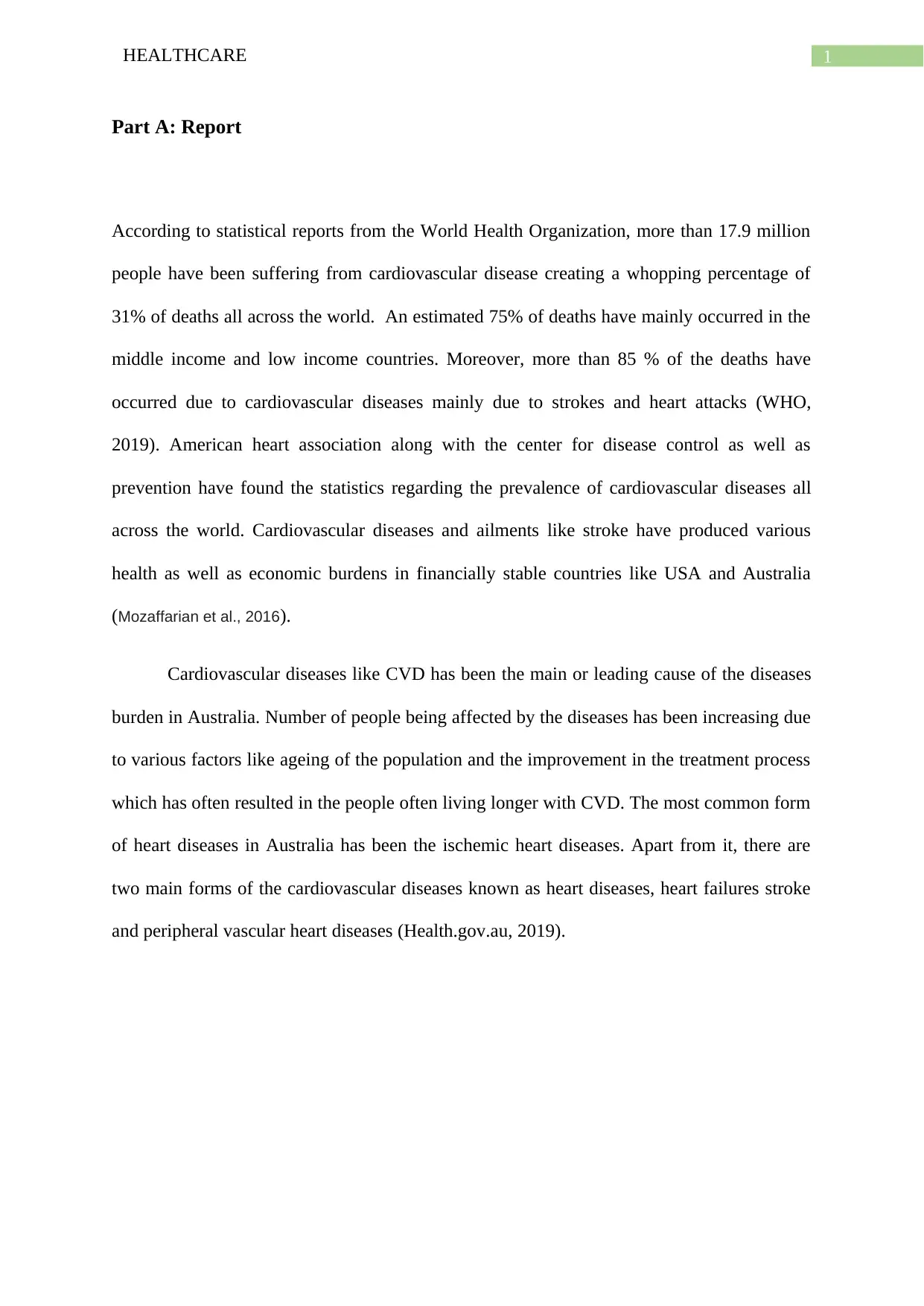
1HEALTHCARE
Part A: Report
According to statistical reports from the World Health Organization, more than 17.9 million
people have been suffering from cardiovascular disease creating a whopping percentage of
31% of deaths all across the world. An estimated 75% of deaths have mainly occurred in the
middle income and low income countries. Moreover, more than 85 % of the deaths have
occurred due to cardiovascular diseases mainly due to strokes and heart attacks (WHO,
2019). American heart association along with the center for disease control as well as
prevention have found the statistics regarding the prevalence of cardiovascular diseases all
across the world. Cardiovascular diseases and ailments like stroke have produced various
health as well as economic burdens in financially stable countries like USA and Australia
(Mozaffarian et al., 2016).
Cardiovascular diseases like CVD has been the main or leading cause of the diseases
burden in Australia. Number of people being affected by the diseases has been increasing due
to various factors like ageing of the population and the improvement in the treatment process
which has often resulted in the people often living longer with CVD. The most common form
of heart diseases in Australia has been the ischemic heart diseases. Apart from it, there are
two main forms of the cardiovascular diseases known as heart diseases, heart failures stroke
and peripheral vascular heart diseases (Health.gov.au, 2019).
Part A: Report
According to statistical reports from the World Health Organization, more than 17.9 million
people have been suffering from cardiovascular disease creating a whopping percentage of
31% of deaths all across the world. An estimated 75% of deaths have mainly occurred in the
middle income and low income countries. Moreover, more than 85 % of the deaths have
occurred due to cardiovascular diseases mainly due to strokes and heart attacks (WHO,
2019). American heart association along with the center for disease control as well as
prevention have found the statistics regarding the prevalence of cardiovascular diseases all
across the world. Cardiovascular diseases and ailments like stroke have produced various
health as well as economic burdens in financially stable countries like USA and Australia
(Mozaffarian et al., 2016).
Cardiovascular diseases like CVD has been the main or leading cause of the diseases
burden in Australia. Number of people being affected by the diseases has been increasing due
to various factors like ageing of the population and the improvement in the treatment process
which has often resulted in the people often living longer with CVD. The most common form
of heart diseases in Australia has been the ischemic heart diseases. Apart from it, there are
two main forms of the cardiovascular diseases known as heart diseases, heart failures stroke
and peripheral vascular heart diseases (Health.gov.au, 2019).
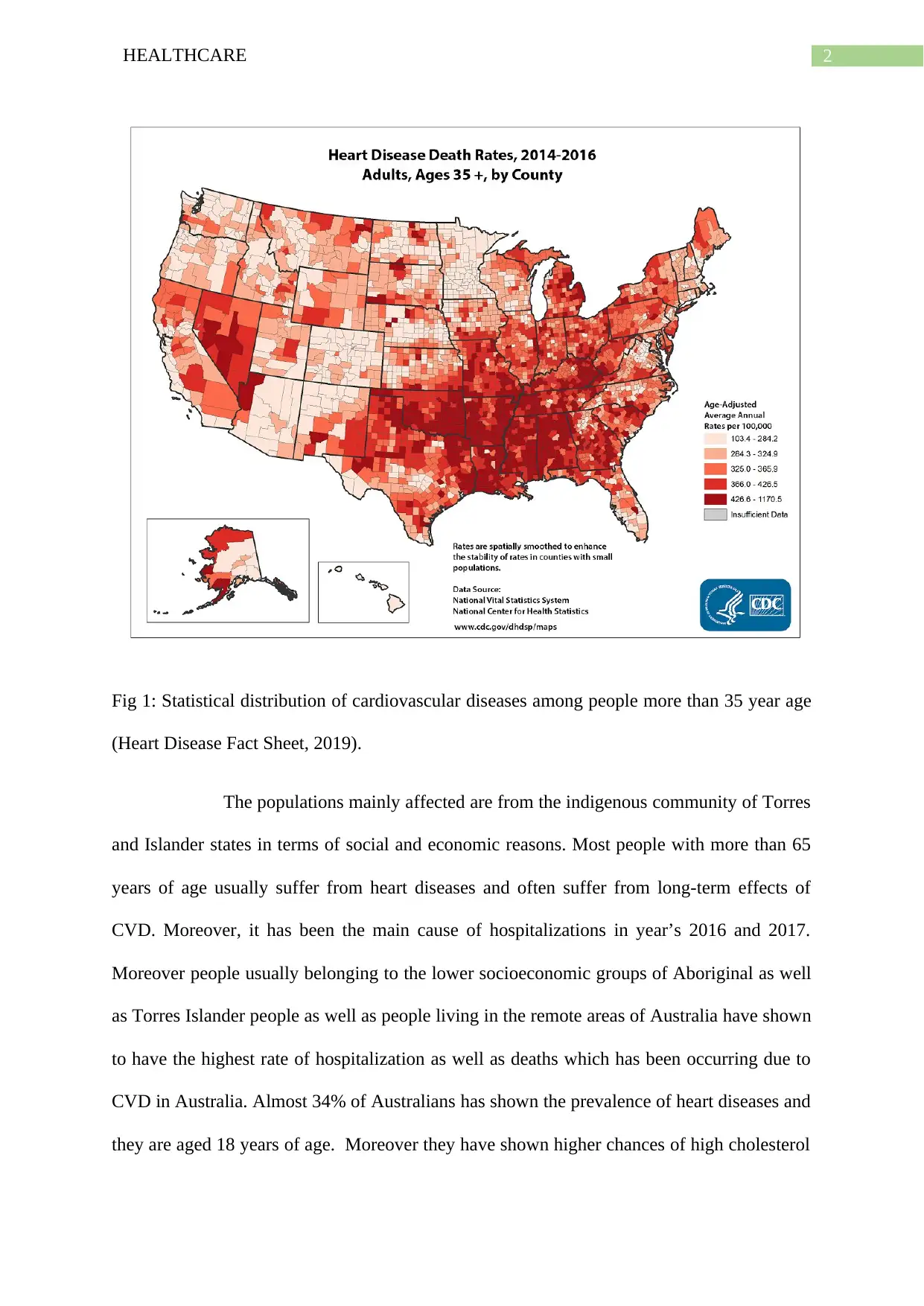
2HEALTHCARE
Fig 1: Statistical distribution of cardiovascular diseases among people more than 35 year age
(Heart Disease Fact Sheet, 2019).
The populations mainly affected are from the indigenous community of Torres
and Islander states in terms of social and economic reasons. Most people with more than 65
years of age usually suffer from heart diseases and often suffer from long-term effects of
CVD. Moreover, it has been the main cause of hospitalizations in year’s 2016 and 2017.
Moreover people usually belonging to the lower socioeconomic groups of Aboriginal as well
as Torres Islander people as well as people living in the remote areas of Australia have shown
to have the highest rate of hospitalization as well as deaths which has been occurring due to
CVD in Australia. Almost 34% of Australians has shown the prevalence of heart diseases and
they are aged 18 years of age. Moreover they have shown higher chances of high cholesterol
Fig 1: Statistical distribution of cardiovascular diseases among people more than 35 year age
(Heart Disease Fact Sheet, 2019).
The populations mainly affected are from the indigenous community of Torres
and Islander states in terms of social and economic reasons. Most people with more than 65
years of age usually suffer from heart diseases and often suffer from long-term effects of
CVD. Moreover, it has been the main cause of hospitalizations in year’s 2016 and 2017.
Moreover people usually belonging to the lower socioeconomic groups of Aboriginal as well
as Torres Islander people as well as people living in the remote areas of Australia have shown
to have the highest rate of hospitalization as well as deaths which has been occurring due to
CVD in Australia. Almost 34% of Australians has shown the prevalence of heart diseases and
they are aged 18 years of age. Moreover they have shown higher chances of high cholesterol
⊘ This is a preview!⊘
Do you want full access?
Subscribe today to unlock all pages.

Trusted by 1+ million students worldwide
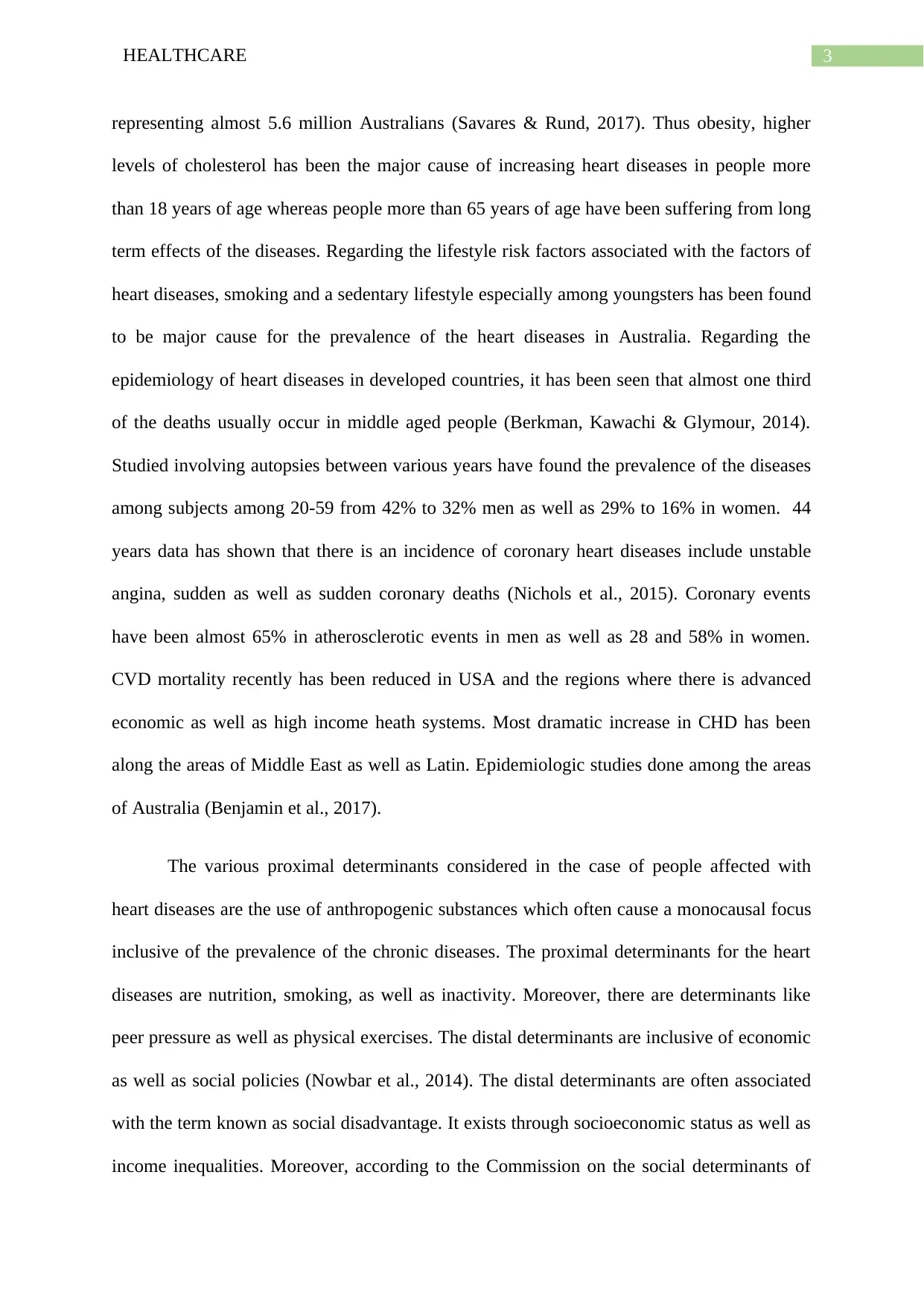
3HEALTHCARE
representing almost 5.6 million Australians (Savares & Rund, 2017). Thus obesity, higher
levels of cholesterol has been the major cause of increasing heart diseases in people more
than 18 years of age whereas people more than 65 years of age have been suffering from long
term effects of the diseases. Regarding the lifestyle risk factors associated with the factors of
heart diseases, smoking and a sedentary lifestyle especially among youngsters has been found
to be major cause for the prevalence of the heart diseases in Australia. Regarding the
epidemiology of heart diseases in developed countries, it has been seen that almost one third
of the deaths usually occur in middle aged people (Berkman, Kawachi & Glymour, 2014).
Studied involving autopsies between various years have found the prevalence of the diseases
among subjects among 20-59 from 42% to 32% men as well as 29% to 16% in women. 44
years data has shown that there is an incidence of coronary heart diseases include unstable
angina, sudden as well as sudden coronary deaths (Nichols et al., 2015). Coronary events
have been almost 65% in atherosclerotic events in men as well as 28 and 58% in women.
CVD mortality recently has been reduced in USA and the regions where there is advanced
economic as well as high income heath systems. Most dramatic increase in CHD has been
along the areas of Middle East as well as Latin. Epidemiologic studies done among the areas
of Australia (Benjamin et al., 2017).
The various proximal determinants considered in the case of people affected with
heart diseases are the use of anthropogenic substances which often cause a monocausal focus
inclusive of the prevalence of the chronic diseases. The proximal determinants for the heart
diseases are nutrition, smoking, as well as inactivity. Moreover, there are determinants like
peer pressure as well as physical exercises. The distal determinants are inclusive of economic
as well as social policies (Nowbar et al., 2014). The distal determinants are often associated
with the term known as social disadvantage. It exists through socioeconomic status as well as
income inequalities. Moreover, according to the Commission on the social determinants of
representing almost 5.6 million Australians (Savares & Rund, 2017). Thus obesity, higher
levels of cholesterol has been the major cause of increasing heart diseases in people more
than 18 years of age whereas people more than 65 years of age have been suffering from long
term effects of the diseases. Regarding the lifestyle risk factors associated with the factors of
heart diseases, smoking and a sedentary lifestyle especially among youngsters has been found
to be major cause for the prevalence of the heart diseases in Australia. Regarding the
epidemiology of heart diseases in developed countries, it has been seen that almost one third
of the deaths usually occur in middle aged people (Berkman, Kawachi & Glymour, 2014).
Studied involving autopsies between various years have found the prevalence of the diseases
among subjects among 20-59 from 42% to 32% men as well as 29% to 16% in women. 44
years data has shown that there is an incidence of coronary heart diseases include unstable
angina, sudden as well as sudden coronary deaths (Nichols et al., 2015). Coronary events
have been almost 65% in atherosclerotic events in men as well as 28 and 58% in women.
CVD mortality recently has been reduced in USA and the regions where there is advanced
economic as well as high income heath systems. Most dramatic increase in CHD has been
along the areas of Middle East as well as Latin. Epidemiologic studies done among the areas
of Australia (Benjamin et al., 2017).
The various proximal determinants considered in the case of people affected with
heart diseases are the use of anthropogenic substances which often cause a monocausal focus
inclusive of the prevalence of the chronic diseases. The proximal determinants for the heart
diseases are nutrition, smoking, as well as inactivity. Moreover, there are determinants like
peer pressure as well as physical exercises. The distal determinants are inclusive of economic
as well as social policies (Nowbar et al., 2014). The distal determinants are often associated
with the term known as social disadvantage. It exists through socioeconomic status as well as
income inequalities. Moreover, according to the Commission on the social determinants of
Paraphrase This Document
Need a fresh take? Get an instant paraphrase of this document with our AI Paraphraser
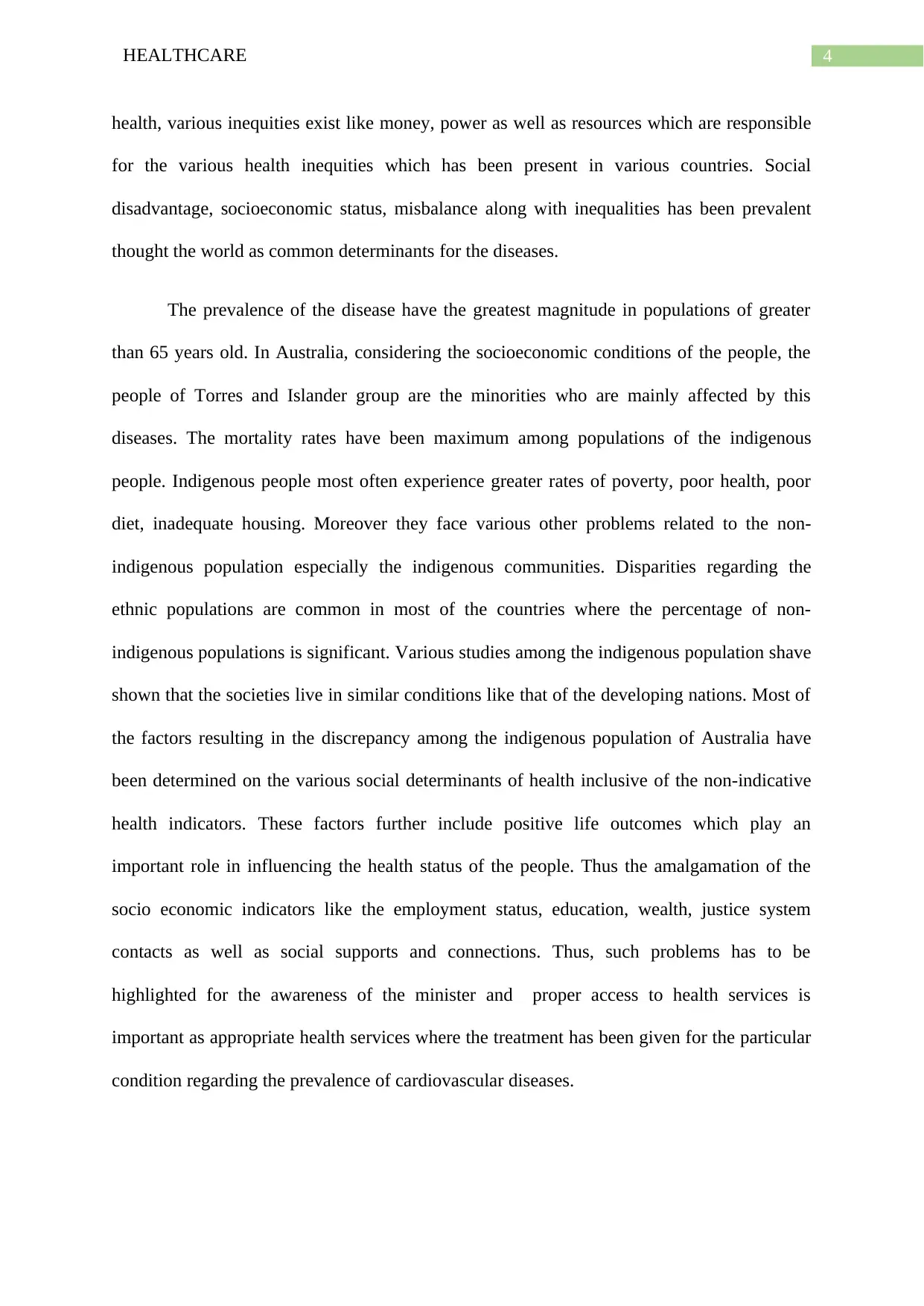
4HEALTHCARE
health, various inequities exist like money, power as well as resources which are responsible
for the various health inequities which has been present in various countries. Social
disadvantage, socioeconomic status, misbalance along with inequalities has been prevalent
thought the world as common determinants for the diseases.
The prevalence of the disease have the greatest magnitude in populations of greater
than 65 years old. In Australia, considering the socioeconomic conditions of the people, the
people of Torres and Islander group are the minorities who are mainly affected by this
diseases. The mortality rates have been maximum among populations of the indigenous
people. Indigenous people most often experience greater rates of poverty, poor health, poor
diet, inadequate housing. Moreover they face various other problems related to the non-
indigenous population especially the indigenous communities. Disparities regarding the
ethnic populations are common in most of the countries where the percentage of non-
indigenous populations is significant. Various studies among the indigenous population shave
shown that the societies live in similar conditions like that of the developing nations. Most of
the factors resulting in the discrepancy among the indigenous population of Australia have
been determined on the various social determinants of health inclusive of the non-indicative
health indicators. These factors further include positive life outcomes which play an
important role in influencing the health status of the people. Thus the amalgamation of the
socio economic indicators like the employment status, education, wealth, justice system
contacts as well as social supports and connections. Thus, such problems has to be
highlighted for the awareness of the minister and proper access to health services is
important as appropriate health services where the treatment has been given for the particular
condition regarding the prevalence of cardiovascular diseases.
health, various inequities exist like money, power as well as resources which are responsible
for the various health inequities which has been present in various countries. Social
disadvantage, socioeconomic status, misbalance along with inequalities has been prevalent
thought the world as common determinants for the diseases.
The prevalence of the disease have the greatest magnitude in populations of greater
than 65 years old. In Australia, considering the socioeconomic conditions of the people, the
people of Torres and Islander group are the minorities who are mainly affected by this
diseases. The mortality rates have been maximum among populations of the indigenous
people. Indigenous people most often experience greater rates of poverty, poor health, poor
diet, inadequate housing. Moreover they face various other problems related to the non-
indigenous population especially the indigenous communities. Disparities regarding the
ethnic populations are common in most of the countries where the percentage of non-
indigenous populations is significant. Various studies among the indigenous population shave
shown that the societies live in similar conditions like that of the developing nations. Most of
the factors resulting in the discrepancy among the indigenous population of Australia have
been determined on the various social determinants of health inclusive of the non-indicative
health indicators. These factors further include positive life outcomes which play an
important role in influencing the health status of the people. Thus the amalgamation of the
socio economic indicators like the employment status, education, wealth, justice system
contacts as well as social supports and connections. Thus, such problems has to be
highlighted for the awareness of the minister and proper access to health services is
important as appropriate health services where the treatment has been given for the particular
condition regarding the prevalence of cardiovascular diseases.

5HEALTHCARE
Part B: Ministerial briefing paper
From:
To:
Action required:
Part B: Ministerial briefing paper
From:
To:
Action required:
⊘ This is a preview!⊘
Do you want full access?
Subscribe today to unlock all pages.

Trusted by 1+ million students worldwide
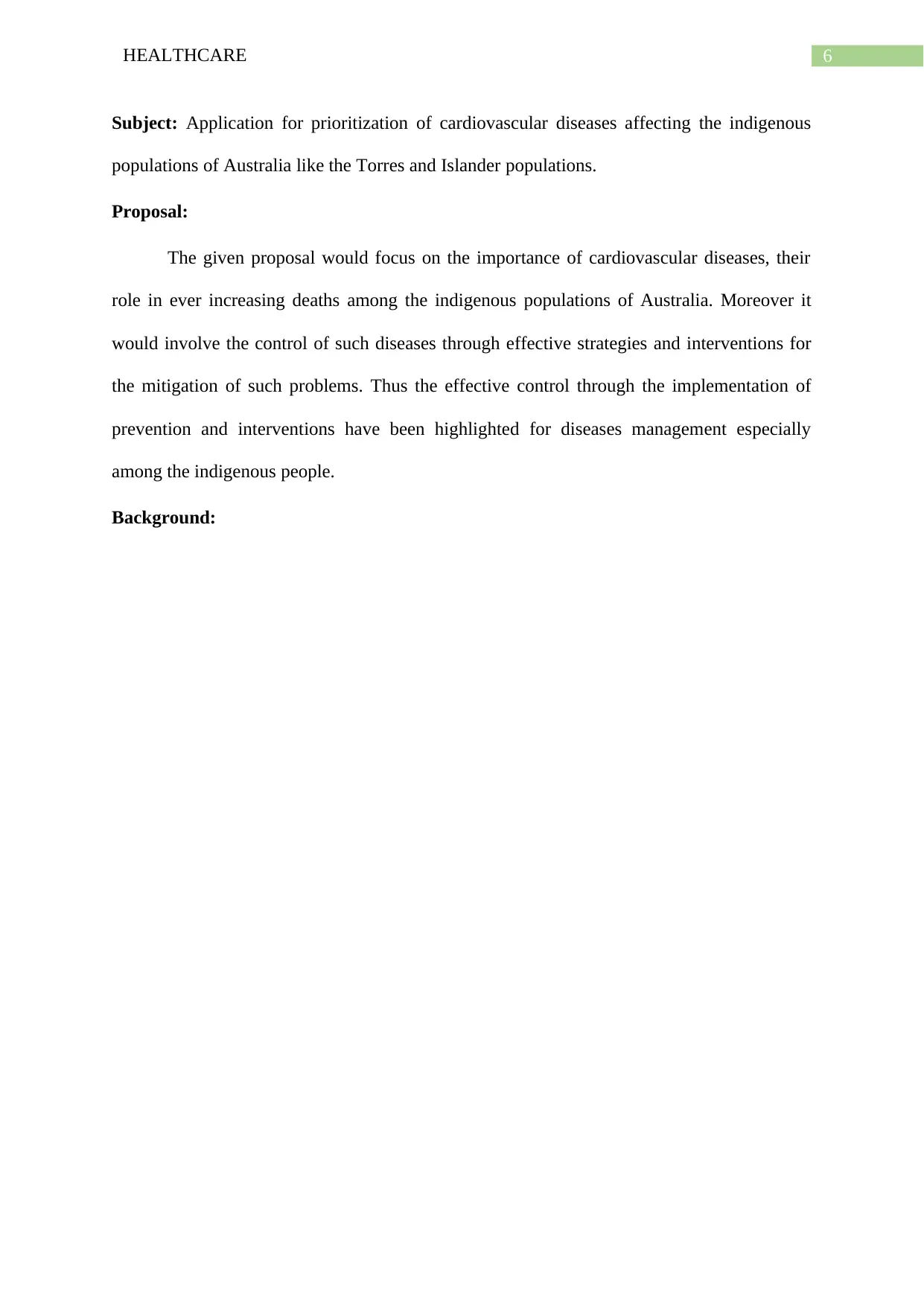
6HEALTHCARE
Subject: Application for prioritization of cardiovascular diseases affecting the indigenous
populations of Australia like the Torres and Islander populations.
Proposal:
The given proposal would focus on the importance of cardiovascular diseases, their
role in ever increasing deaths among the indigenous populations of Australia. Moreover it
would involve the control of such diseases through effective strategies and interventions for
the mitigation of such problems. Thus the effective control through the implementation of
prevention and interventions have been highlighted for diseases management especially
among the indigenous people.
Background:
Subject: Application for prioritization of cardiovascular diseases affecting the indigenous
populations of Australia like the Torres and Islander populations.
Proposal:
The given proposal would focus on the importance of cardiovascular diseases, their
role in ever increasing deaths among the indigenous populations of Australia. Moreover it
would involve the control of such diseases through effective strategies and interventions for
the mitigation of such problems. Thus the effective control through the implementation of
prevention and interventions have been highlighted for diseases management especially
among the indigenous people.
Background:
Paraphrase This Document
Need a fresh take? Get an instant paraphrase of this document with our AI Paraphraser
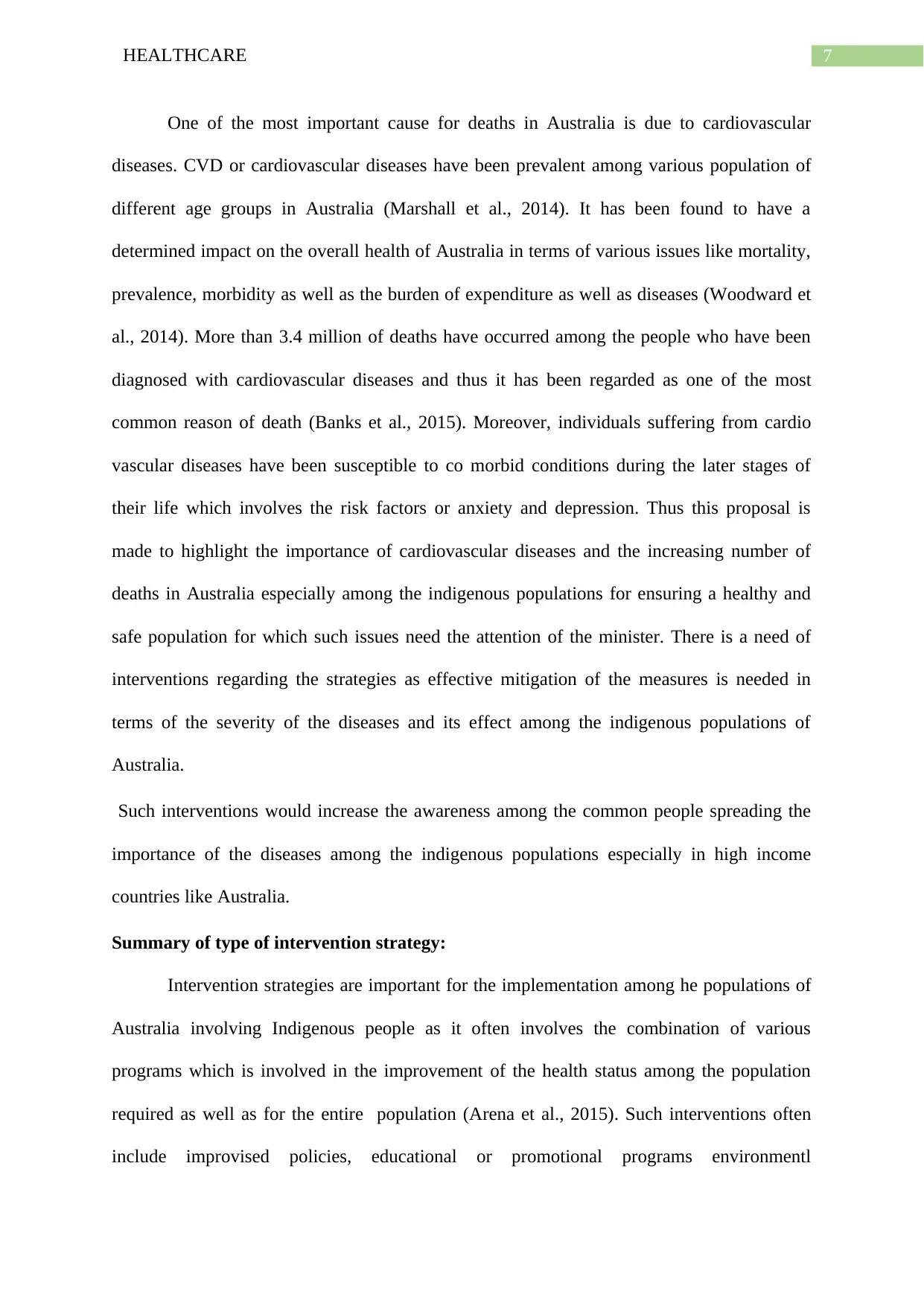
7HEALTHCARE
One of the most important cause for deaths in Australia is due to cardiovascular
diseases. CVD or cardiovascular diseases have been prevalent among various population of
different age groups in Australia (Marshall et al., 2014). It has been found to have a
determined impact on the overall health of Australia in terms of various issues like mortality,
prevalence, morbidity as well as the burden of expenditure as well as diseases (Woodward et
al., 2014). More than 3.4 million of deaths have occurred among the people who have been
diagnosed with cardiovascular diseases and thus it has been regarded as one of the most
common reason of death (Banks et al., 2015). Moreover, individuals suffering from cardio
vascular diseases have been susceptible to co morbid conditions during the later stages of
their life which involves the risk factors or anxiety and depression. Thus this proposal is
made to highlight the importance of cardiovascular diseases and the increasing number of
deaths in Australia especially among the indigenous populations for ensuring a healthy and
safe population for which such issues need the attention of the minister. There is a need of
interventions regarding the strategies as effective mitigation of the measures is needed in
terms of the severity of the diseases and its effect among the indigenous populations of
Australia.
Such interventions would increase the awareness among the common people spreading the
importance of the diseases among the indigenous populations especially in high income
countries like Australia.
Summary of type of intervention strategy:
Intervention strategies are important for the implementation among he populations of
Australia involving Indigenous people as it often involves the combination of various
programs which is involved in the improvement of the health status among the population
required as well as for the entire population (Arena et al., 2015). Such interventions often
include improvised policies, educational or promotional programs environmentl
One of the most important cause for deaths in Australia is due to cardiovascular
diseases. CVD or cardiovascular diseases have been prevalent among various population of
different age groups in Australia (Marshall et al., 2014). It has been found to have a
determined impact on the overall health of Australia in terms of various issues like mortality,
prevalence, morbidity as well as the burden of expenditure as well as diseases (Woodward et
al., 2014). More than 3.4 million of deaths have occurred among the people who have been
diagnosed with cardiovascular diseases and thus it has been regarded as one of the most
common reason of death (Banks et al., 2015). Moreover, individuals suffering from cardio
vascular diseases have been susceptible to co morbid conditions during the later stages of
their life which involves the risk factors or anxiety and depression. Thus this proposal is
made to highlight the importance of cardiovascular diseases and the increasing number of
deaths in Australia especially among the indigenous populations for ensuring a healthy and
safe population for which such issues need the attention of the minister. There is a need of
interventions regarding the strategies as effective mitigation of the measures is needed in
terms of the severity of the diseases and its effect among the indigenous populations of
Australia.
Such interventions would increase the awareness among the common people spreading the
importance of the diseases among the indigenous populations especially in high income
countries like Australia.
Summary of type of intervention strategy:
Intervention strategies are important for the implementation among he populations of
Australia involving Indigenous people as it often involves the combination of various
programs which is involved in the improvement of the health status among the population
required as well as for the entire population (Arena et al., 2015). Such interventions often
include improvised policies, educational or promotional programs environmentl
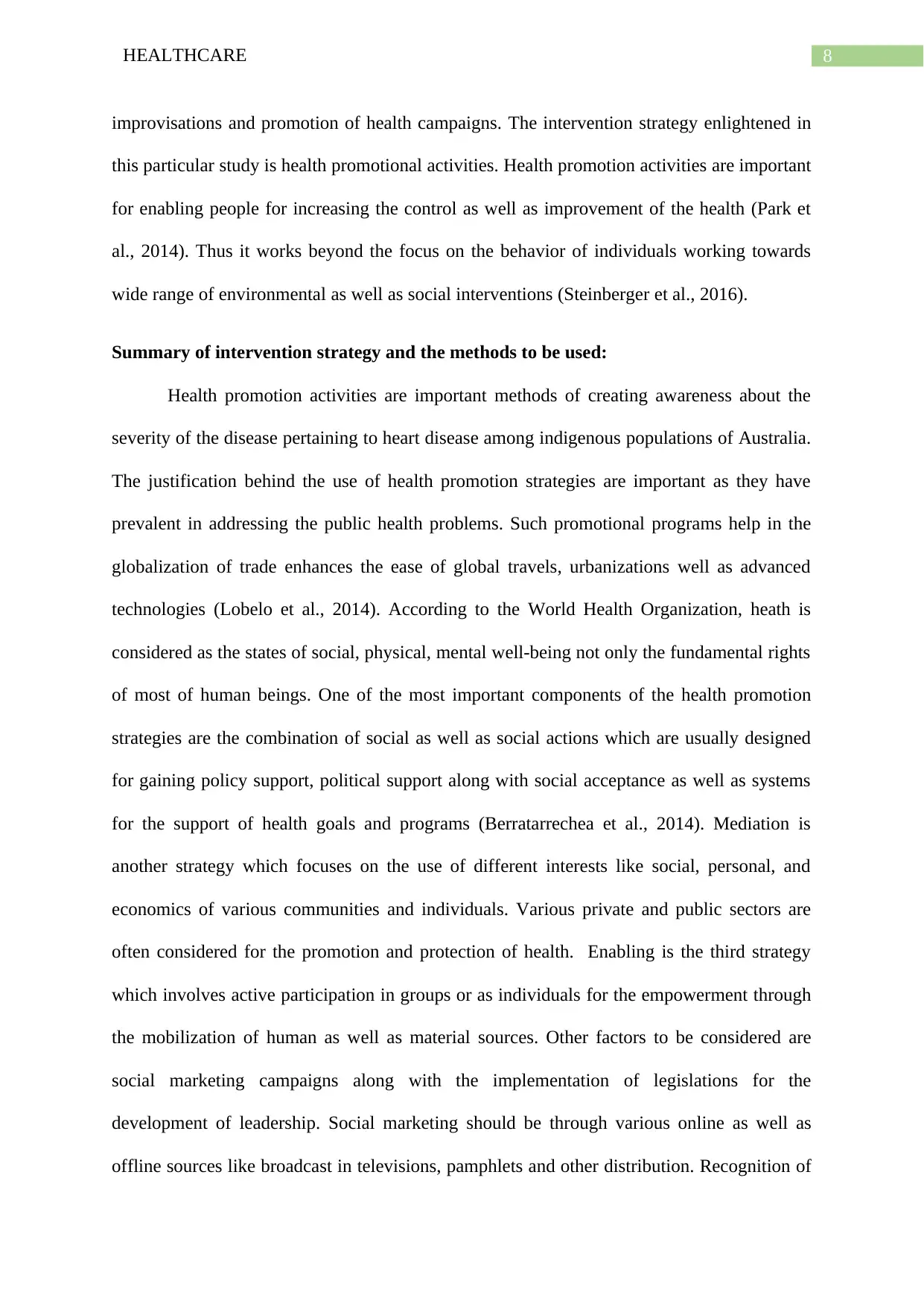
8HEALTHCARE
improvisations and promotion of health campaigns. The intervention strategy enlightened in
this particular study is health promotional activities. Health promotion activities are important
for enabling people for increasing the control as well as improvement of the health (Park et
al., 2014). Thus it works beyond the focus on the behavior of individuals working towards
wide range of environmental as well as social interventions (Steinberger et al., 2016).
Summary of intervention strategy and the methods to be used:
Health promotion activities are important methods of creating awareness about the
severity of the disease pertaining to heart disease among indigenous populations of Australia.
The justification behind the use of health promotion strategies are important as they have
prevalent in addressing the public health problems. Such promotional programs help in the
globalization of trade enhances the ease of global travels, urbanizations well as advanced
technologies (Lobelo et al., 2014). According to the World Health Organization, heath is
considered as the states of social, physical, mental well-being not only the fundamental rights
of most of human beings. One of the most important components of the health promotion
strategies are the combination of social as well as social actions which are usually designed
for gaining policy support, political support along with social acceptance as well as systems
for the support of health goals and programs (Berratarrechea et al., 2014). Mediation is
another strategy which focuses on the use of different interests like social, personal, and
economics of various communities and individuals. Various private and public sectors are
often considered for the promotion and protection of health. Enabling is the third strategy
which involves active participation in groups or as individuals for the empowerment through
the mobilization of human as well as material sources. Other factors to be considered are
social marketing campaigns along with the implementation of legislations for the
development of leadership. Social marketing should be through various online as well as
offline sources like broadcast in televisions, pamphlets and other distribution. Recognition of
improvisations and promotion of health campaigns. The intervention strategy enlightened in
this particular study is health promotional activities. Health promotion activities are important
for enabling people for increasing the control as well as improvement of the health (Park et
al., 2014). Thus it works beyond the focus on the behavior of individuals working towards
wide range of environmental as well as social interventions (Steinberger et al., 2016).
Summary of intervention strategy and the methods to be used:
Health promotion activities are important methods of creating awareness about the
severity of the disease pertaining to heart disease among indigenous populations of Australia.
The justification behind the use of health promotion strategies are important as they have
prevalent in addressing the public health problems. Such promotional programs help in the
globalization of trade enhances the ease of global travels, urbanizations well as advanced
technologies (Lobelo et al., 2014). According to the World Health Organization, heath is
considered as the states of social, physical, mental well-being not only the fundamental rights
of most of human beings. One of the most important components of the health promotion
strategies are the combination of social as well as social actions which are usually designed
for gaining policy support, political support along with social acceptance as well as systems
for the support of health goals and programs (Berratarrechea et al., 2014). Mediation is
another strategy which focuses on the use of different interests like social, personal, and
economics of various communities and individuals. Various private and public sectors are
often considered for the promotion and protection of health. Enabling is the third strategy
which involves active participation in groups or as individuals for the empowerment through
the mobilization of human as well as material sources. Other factors to be considered are
social marketing campaigns along with the implementation of legislations for the
development of leadership. Social marketing should be through various online as well as
offline sources like broadcast in televisions, pamphlets and other distribution. Recognition of
⊘ This is a preview!⊘
Do you want full access?
Subscribe today to unlock all pages.

Trusted by 1+ million students worldwide
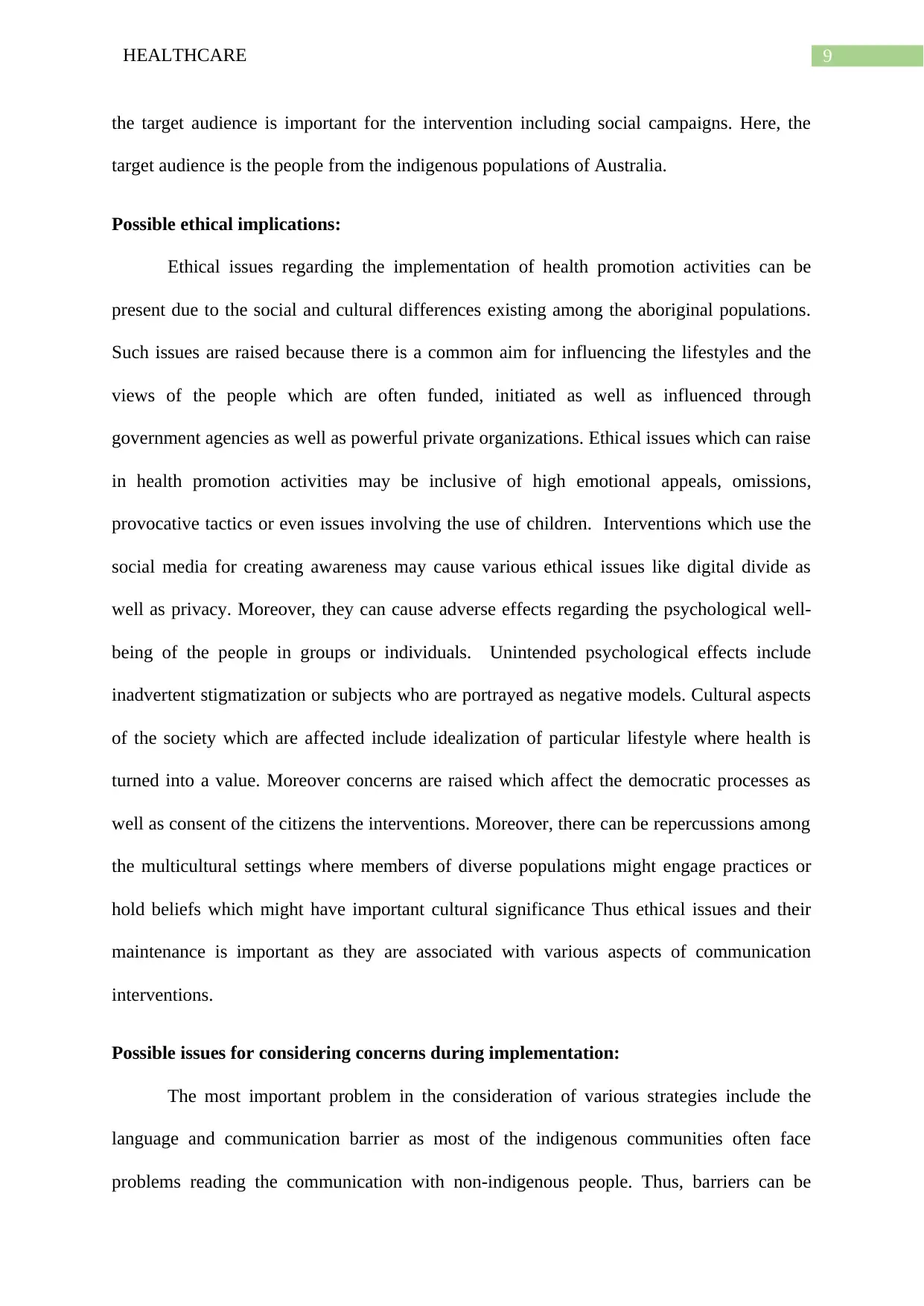
9HEALTHCARE
the target audience is important for the intervention including social campaigns. Here, the
target audience is the people from the indigenous populations of Australia.
Possible ethical implications:
Ethical issues regarding the implementation of health promotion activities can be
present due to the social and cultural differences existing among the aboriginal populations.
Such issues are raised because there is a common aim for influencing the lifestyles and the
views of the people which are often funded, initiated as well as influenced through
government agencies as well as powerful private organizations. Ethical issues which can raise
in health promotion activities may be inclusive of high emotional appeals, omissions,
provocative tactics or even issues involving the use of children. Interventions which use the
social media for creating awareness may cause various ethical issues like digital divide as
well as privacy. Moreover, they can cause adverse effects regarding the psychological well-
being of the people in groups or individuals. Unintended psychological effects include
inadvertent stigmatization or subjects who are portrayed as negative models. Cultural aspects
of the society which are affected include idealization of particular lifestyle where health is
turned into a value. Moreover concerns are raised which affect the democratic processes as
well as consent of the citizens the interventions. Moreover, there can be repercussions among
the multicultural settings where members of diverse populations might engage practices or
hold beliefs which might have important cultural significance Thus ethical issues and their
maintenance is important as they are associated with various aspects of communication
interventions.
Possible issues for considering concerns during implementation:
The most important problem in the consideration of various strategies include the
language and communication barrier as most of the indigenous communities often face
problems reading the communication with non-indigenous people. Thus, barriers can be
the target audience is important for the intervention including social campaigns. Here, the
target audience is the people from the indigenous populations of Australia.
Possible ethical implications:
Ethical issues regarding the implementation of health promotion activities can be
present due to the social and cultural differences existing among the aboriginal populations.
Such issues are raised because there is a common aim for influencing the lifestyles and the
views of the people which are often funded, initiated as well as influenced through
government agencies as well as powerful private organizations. Ethical issues which can raise
in health promotion activities may be inclusive of high emotional appeals, omissions,
provocative tactics or even issues involving the use of children. Interventions which use the
social media for creating awareness may cause various ethical issues like digital divide as
well as privacy. Moreover, they can cause adverse effects regarding the psychological well-
being of the people in groups or individuals. Unintended psychological effects include
inadvertent stigmatization or subjects who are portrayed as negative models. Cultural aspects
of the society which are affected include idealization of particular lifestyle where health is
turned into a value. Moreover concerns are raised which affect the democratic processes as
well as consent of the citizens the interventions. Moreover, there can be repercussions among
the multicultural settings where members of diverse populations might engage practices or
hold beliefs which might have important cultural significance Thus ethical issues and their
maintenance is important as they are associated with various aspects of communication
interventions.
Possible issues for considering concerns during implementation:
The most important problem in the consideration of various strategies include the
language and communication barrier as most of the indigenous communities often face
problems reading the communication with non-indigenous people. Thus, barriers can be
Paraphrase This Document
Need a fresh take? Get an instant paraphrase of this document with our AI Paraphraser
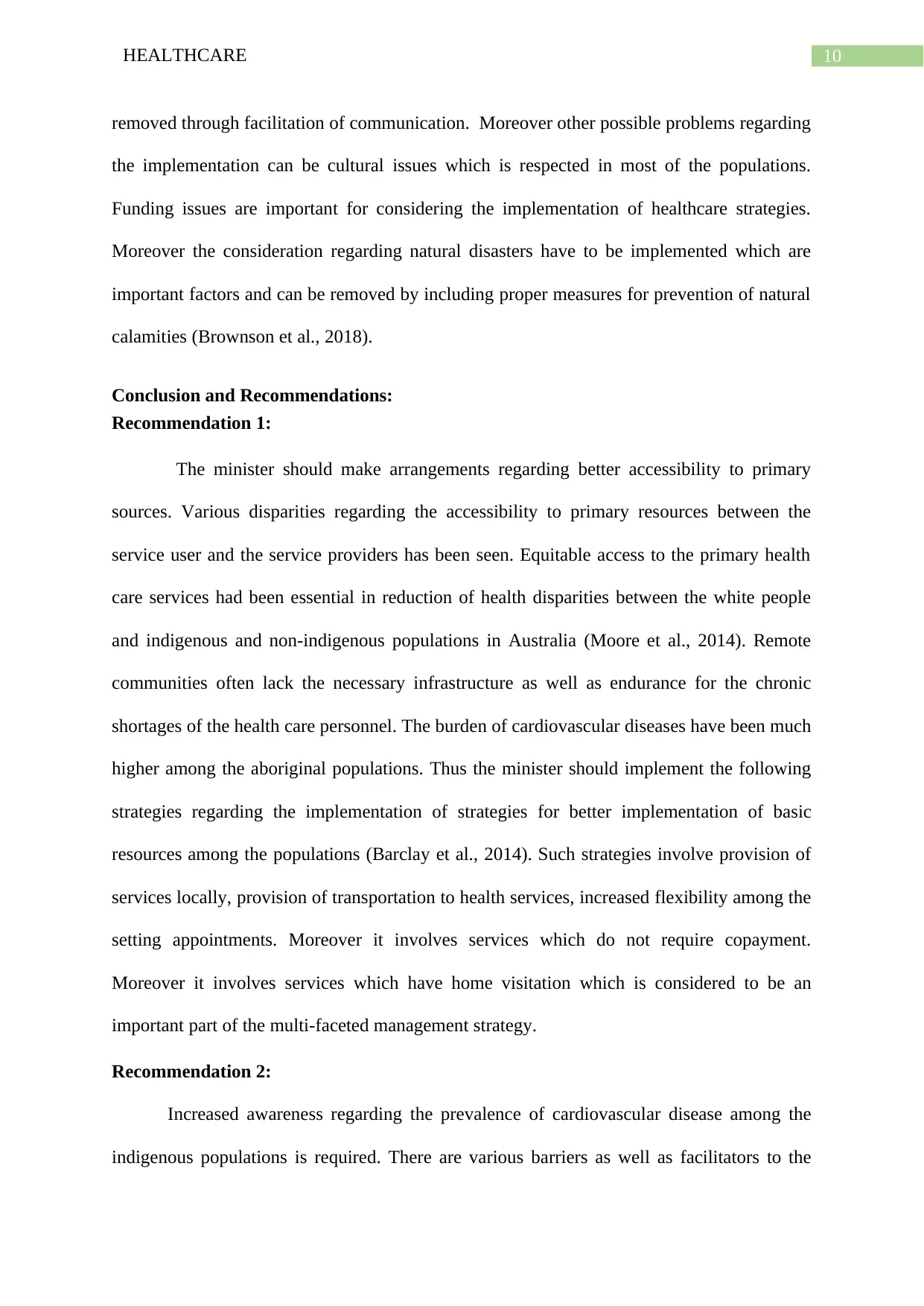
10HEALTHCARE
removed through facilitation of communication. Moreover other possible problems regarding
the implementation can be cultural issues which is respected in most of the populations.
Funding issues are important for considering the implementation of healthcare strategies.
Moreover the consideration regarding natural disasters have to be implemented which are
important factors and can be removed by including proper measures for prevention of natural
calamities (Brownson et al., 2018).
Conclusion and Recommendations:
Recommendation 1:
The minister should make arrangements regarding better accessibility to primary
sources. Various disparities regarding the accessibility to primary resources between the
service user and the service providers has been seen. Equitable access to the primary health
care services had been essential in reduction of health disparities between the white people
and indigenous and non-indigenous populations in Australia (Moore et al., 2014). Remote
communities often lack the necessary infrastructure as well as endurance for the chronic
shortages of the health care personnel. The burden of cardiovascular diseases have been much
higher among the aboriginal populations. Thus the minister should implement the following
strategies regarding the implementation of strategies for better implementation of basic
resources among the populations (Barclay et al., 2014). Such strategies involve provision of
services locally, provision of transportation to health services, increased flexibility among the
setting appointments. Moreover it involves services which do not require copayment.
Moreover it involves services which have home visitation which is considered to be an
important part of the multi-faceted management strategy.
Recommendation 2:
Increased awareness regarding the prevalence of cardiovascular disease among the
indigenous populations is required. There are various barriers as well as facilitators to the
removed through facilitation of communication. Moreover other possible problems regarding
the implementation can be cultural issues which is respected in most of the populations.
Funding issues are important for considering the implementation of healthcare strategies.
Moreover the consideration regarding natural disasters have to be implemented which are
important factors and can be removed by including proper measures for prevention of natural
calamities (Brownson et al., 2018).
Conclusion and Recommendations:
Recommendation 1:
The minister should make arrangements regarding better accessibility to primary
sources. Various disparities regarding the accessibility to primary resources between the
service user and the service providers has been seen. Equitable access to the primary health
care services had been essential in reduction of health disparities between the white people
and indigenous and non-indigenous populations in Australia (Moore et al., 2014). Remote
communities often lack the necessary infrastructure as well as endurance for the chronic
shortages of the health care personnel. The burden of cardiovascular diseases have been much
higher among the aboriginal populations. Thus the minister should implement the following
strategies regarding the implementation of strategies for better implementation of basic
resources among the populations (Barclay et al., 2014). Such strategies involve provision of
services locally, provision of transportation to health services, increased flexibility among the
setting appointments. Moreover it involves services which do not require copayment.
Moreover it involves services which have home visitation which is considered to be an
important part of the multi-faceted management strategy.
Recommendation 2:
Increased awareness regarding the prevalence of cardiovascular disease among the
indigenous populations is required. There are various barriers as well as facilitators to the
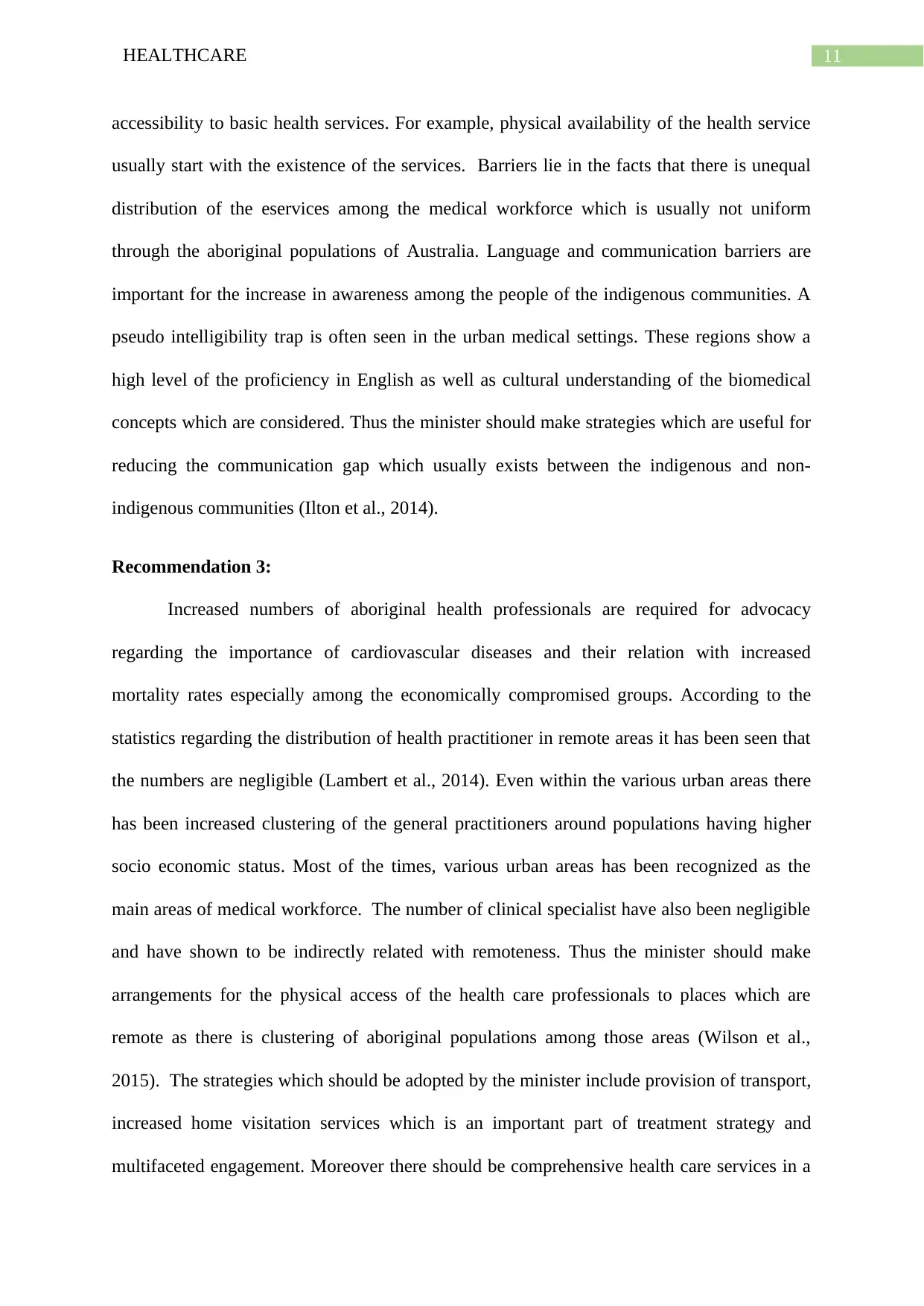
11HEALTHCARE
accessibility to basic health services. For example, physical availability of the health service
usually start with the existence of the services. Barriers lie in the facts that there is unequal
distribution of the eservices among the medical workforce which is usually not uniform
through the aboriginal populations of Australia. Language and communication barriers are
important for the increase in awareness among the people of the indigenous communities. A
pseudo intelligibility trap is often seen in the urban medical settings. These regions show a
high level of the proficiency in English as well as cultural understanding of the biomedical
concepts which are considered. Thus the minister should make strategies which are useful for
reducing the communication gap which usually exists between the indigenous and non-
indigenous communities (Ilton et al., 2014).
Recommendation 3:
Increased numbers of aboriginal health professionals are required for advocacy
regarding the importance of cardiovascular diseases and their relation with increased
mortality rates especially among the economically compromised groups. According to the
statistics regarding the distribution of health practitioner in remote areas it has been seen that
the numbers are negligible (Lambert et al., 2014). Even within the various urban areas there
has been increased clustering of the general practitioners around populations having higher
socio economic status. Most of the times, various urban areas has been recognized as the
main areas of medical workforce. The number of clinical specialist have also been negligible
and have shown to be indirectly related with remoteness. Thus the minister should make
arrangements for the physical access of the health care professionals to places which are
remote as there is clustering of aboriginal populations among those areas (Wilson et al.,
2015). The strategies which should be adopted by the minister include provision of transport,
increased home visitation services which is an important part of treatment strategy and
multifaceted engagement. Moreover there should be comprehensive health care services in a
accessibility to basic health services. For example, physical availability of the health service
usually start with the existence of the services. Barriers lie in the facts that there is unequal
distribution of the eservices among the medical workforce which is usually not uniform
through the aboriginal populations of Australia. Language and communication barriers are
important for the increase in awareness among the people of the indigenous communities. A
pseudo intelligibility trap is often seen in the urban medical settings. These regions show a
high level of the proficiency in English as well as cultural understanding of the biomedical
concepts which are considered. Thus the minister should make strategies which are useful for
reducing the communication gap which usually exists between the indigenous and non-
indigenous communities (Ilton et al., 2014).
Recommendation 3:
Increased numbers of aboriginal health professionals are required for advocacy
regarding the importance of cardiovascular diseases and their relation with increased
mortality rates especially among the economically compromised groups. According to the
statistics regarding the distribution of health practitioner in remote areas it has been seen that
the numbers are negligible (Lambert et al., 2014). Even within the various urban areas there
has been increased clustering of the general practitioners around populations having higher
socio economic status. Most of the times, various urban areas has been recognized as the
main areas of medical workforce. The number of clinical specialist have also been negligible
and have shown to be indirectly related with remoteness. Thus the minister should make
arrangements for the physical access of the health care professionals to places which are
remote as there is clustering of aboriginal populations among those areas (Wilson et al.,
2015). The strategies which should be adopted by the minister include provision of transport,
increased home visitation services which is an important part of treatment strategy and
multifaceted engagement. Moreover there should be comprehensive health care services in a
⊘ This is a preview!⊘
Do you want full access?
Subscribe today to unlock all pages.

Trusted by 1+ million students worldwide
1 out of 20
Related Documents
Your All-in-One AI-Powered Toolkit for Academic Success.
+13062052269
info@desklib.com
Available 24*7 on WhatsApp / Email
![[object Object]](/_next/static/media/star-bottom.7253800d.svg)
Unlock your academic potential
Copyright © 2020–2025 A2Z Services. All Rights Reserved. Developed and managed by ZUCOL.




